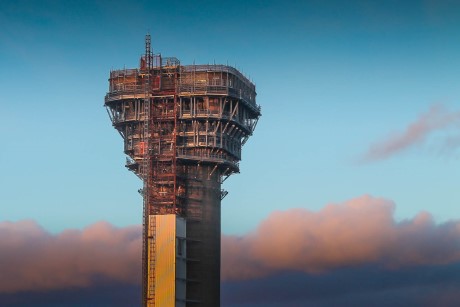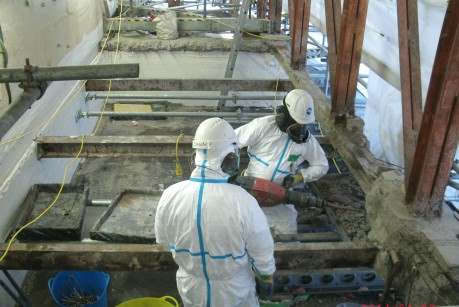Chimney work changes Sellafield skyline
17 April 2014
Work to decommission the iconic filter gallery on the last remaining chimney from the UK's historic Windscale reactors has reached the half-way point.
 |
The filter gallery of Windscale Pile One's chimney is gradually disappearing
(Image: Sellafield Ltd) |
Two chimneys providing ventilation for the Windscale piles, early reactors built to produce plutonium for the UK's nuclear weapons program, were sealed after Pile One was damaged beyond repair in a 1957 fire. The Windscale chimneys, with the characteristic bulge of the filters at their top, remained a feature of the Sellafield skyline until 2001 when the chimney servicing Pile Two was reduced to the height of adjacent buildings.
The chimneys were built in the late 1940s and early 1950s, and were retrofitted with high-performance filters at the insistence of Nobel prize-winning physicist John Cockcroft. The filters quickly became known as 'Cockcroft's Follies', but proved their worth when the filter at the top of Pile One's chimney trapped most of the radionuclides released when the reactor caught fire in what was, at the time, the world's worst nuclear accident.
The contaminated filters themselves were removed not long after the fire, and the chimney sealed up to allow radiation to decay. It was reopened in 2013 to allow demolition work to commence, starting with the removal of the filter gallery, a 530-tonne structure of steel, brick and concrete. Conventional demolition techniques are being used, breaking up the concrete and rubble by core drilling. The rubble is then transferred to the ground, one tonne at a time, in a small goods hoist.
 |
| Conventional demolition techniques are being used to remove the filter gallery (Image: Sellafield Ltd) |
So far, an estimated 172 tonnes of steelwork, 66 tonnes of brick and 150 tonnes of concrete have been brought down. All of the waste has been monitored for contamination and most has been found suitable for disposal in a landfill facility on the Sellafield site. Current plans envisage the removal of the gallery to be completed by October, after which preparations will be made to remove the 1400 tonne concrete diffuser box sitting below the filter gallery.
Jeremy Hunt, head of decommissioning projects for Sellafield Ltd, described the decommissioning challenges posed by the chimney as unique and complex thanks to both radiological and conventional decommissioning considerations. "There's no instruction manual for the job and we have to prove the decommissioning techniques chosen can be used 100% safely," he said.
Sellafield Ltd is responsible for the decommissioning of the nuclear legacy site on behalf of the UK's Nuclear Decommissioning Authority, and is owned and operated by Nuclear Management Partners.
Researched and written
by World Nuclear News